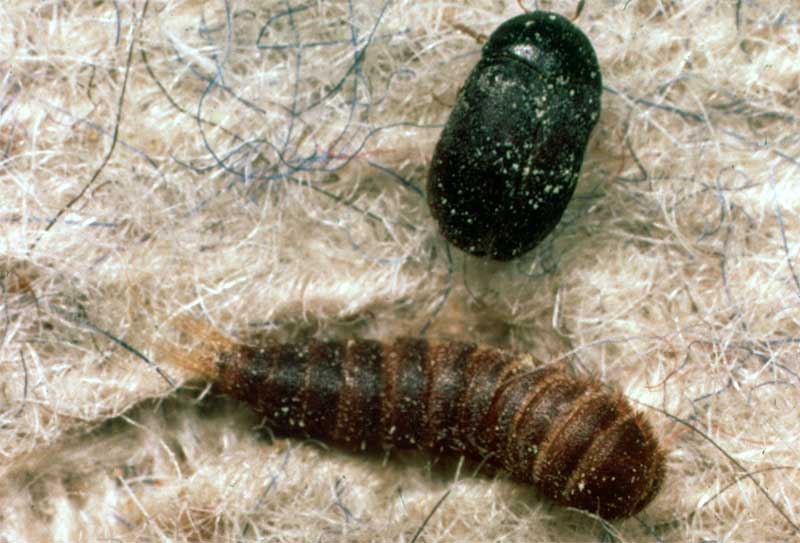
Carpet beetles are common household pests that can cause significant damage to natural fibers and stored products. Understanding how to identify and control these pests is crucial to protect your home and belongings. This article provides a comprehensive guide to recognizing and managing carpet beetles, helping you get rid of your pests effectively.
Identifying Carpet Beetles
Physical Characteristics
Carpet beetles are small, oval-shaped insects that can vary in color. There are several species, but the most common ones found in homes include the varied carpet beetle, the black carpet beetle, and the furniture carpet beetle.
- Varied Carpet Beetle: These beetles are about 3 mm long, with a mix of white, brown, yellow, and black scales on their back, giving them a mottled appearance.
- Black Carpet Beetle: Typically 3-5 mm long, these beetles are dark brown or black and have shiny, smooth bodies.
- Furniture Carpet Beetle: These beetles are similar in size to the varied carpet beetle but have a distinctive pattern of white, brown, and yellow scales.
Life Cycle
Carpet beetles go through a complete metamorphosis: egg, larva, pupa, and adult. The larval stage is the most destructive.
- Eggs: Carpet beetles lay their eggs in dark, undisturbed places. The eggs hatch in about two weeks.
- Larvae: The larvae, often called “woolly bears,” are responsible for most of the damage. They are hairy and can be brown or tan. Larvae can survive for several months up to a year, depending on environmental conditions.
- Pupae: The pupal stage lasts a few weeks, during which the larvae transform into adults.
- Adults: Adult beetles are typically attracted to light and can often be found near windows. They feed on pollen and nectar and do not cause damage indoors.
Signs of Infestation
Recognizing the signs of a carpet beetle infestation is essential for early intervention.
- Shed Skins: Larvae shed their skins several times as they grow, leaving behind small, brown, shell-like cases.
- Damage to Fabrics: Irregular holes in natural fibers such as wool, silk, leather, and fur are a clear sign of carpet beetle larvae feeding.
- Dead Insects: Finding dead carpet beetles on windowsills and near light sources indicates their presence.
Controlling Carpet Beetles
Prevention
Preventing carpet beetle infestations involves maintaining a clean home and properly storing susceptible items.
- Regular Cleaning: Vacuum carpets, rugs, and upholstered furniture regularly to remove larvae and eggs. Pay special attention to edges, corners, and under furniture.
- Proper Storage: Store off-season clothing and natural fiber items in airtight containers to prevent access by larvae.
- Inspect Second-Hand Items: Check second-hand furniture, clothing, and rugs for signs of infestation before bringing them into your home.
Natural Remedies
Natural remedies can be effective in controlling carpet beetles without using harsh chemicals.
- Diatomaceous Earth: Sprinkle diatomaceous earth on carpets and rugs. This natural powder kills insects by dehydrating them.
- Essential Oils: Essential oils like cedarwood, lavender, and eucalyptus can repel carpet beetles. Mix with water and spray on vulnerable items and areas.
- Vinegar: Wipe down surfaces with a solution of vinegar and water to remove dirt and disrupt the scent trails of carpet beetles.
Chemical Treatments
In cases of severe infestations, chemical treatments may be necessary.
- Insecticides: Use insecticides specifically labeled for carpet beetles. Apply to carpets, rugs, and cracks and crevices where larvae may hide.
- Foggers: In extreme cases, insect foggers or “bug bombs” can be used to treat large areas. Ensure you follow all safety instructions and precautions.

Professional Pest Control
For persistent or widespread infestations, professional pest control services can provide more effective solutions.
- Thorough Inspection: Professionals can conduct a thorough inspection to identify the extent of the infestation and locate hidden larvae and eggs.
- Targeted Treatments: Pest control experts can apply targeted treatments to eliminate carpet beetles and prevent future infestations.
- Preventive Advice: Professionals can offer advice on how to prevent future infestations and maintain a pest-free home.
Conclusion
Carpet beetles can cause significant damage to natural fibers and stored products, making early identification and control essential. By recognizing the physical characteristics, life cycle, and signs of infestation, you can take proactive measures to get rid of your pests. Implementing preventive strategies, using natural remedies, and, if necessary, resorting to chemical treatments or professional pest control will help protect your home from these destructive insects. With these steps, you can effectively manage and eliminate carpet beetle infestations, ensuring a safe and damage-free living environment.




